In a small greenhouse under the shadow of the Sierra Nevada, a botanist meticulously strokes the pollen of endangered wildflowers with a paintbrush, attempting to mimic nature. This effort is part of a larger experiment by a lithium mining company to prevent the extinction of an extremely rare desert plant, Tiehm’s buckwheat. The battle pits clean energy initiatives against native biodiversity conservation.
Australia-based Ioneer aims to mine lithium in the Nevada desert, a project that could more than quadruple U.S. lithium production, essential for electric vehicle batteries and other clean energy projects. However, conservationists are vehemently opposing the mine, which threatens the only known habitat of Tiehm’s buckwheat, a plant crucial for biodiversity.
The U.S. Bureau of Land Management (BLM) has backed Ioneer’s strategy to propagate and transplant the buckwheat in its draft environmental impact statement. The plan awaits further review from the Fish and Wildlife Service, which has previously raised concerns.
Conservationists argue that mining will destroy the plant’s habitat, and efforts to transplant greenhouse-grown specimens are unproven. They emphasize that it could take centuries to determine if the transplanted buckwheat can thrive in the wild, replicating the delicate balance of pollinators, climate, soil conditions, and minerals.
“This latest plan for Rhyolite Ridge Mine is just greenwashing extinction,” said Patrick Donnelly, the Center for Biological Diversity’s Great Basin director. He pledged legal action if the mine is approved, claiming that the destruction of habitat is certain, while the success of mitigation is uncertain.
Since 2016, Ioneer has been exploring the mineral deposit on Rhyolite Ridge. Arnold Tiehm, the plant’s namesake, suggested in 1994 that the site be protected from mining, but it was only in 2022 that conservationists secured endangered status and critical habitat designation for the plant.
The Biden administration has shown support for strengthening the nation’s battery supply chain, approving permits and funding similar projects. The mine is projected to produce enough lithium carbonate annually for 370,000 electric vehicle batteries over its 26-year lifespan.
“Ioneer is confident in our ability to quadruple the nation’s supply of lithium while protecting Tiehm’s buckwheat,” said company Vice President Chad Yeftich.
Near the Nevada-California border, about 25,000 of these plants exist in the wild. Discovered in the mid-1980s, they resemble a scrawny dandelion during their brief blooming period each year. At a greenhouse south of Carson City, Ioneer botanist Florencia Peredo Ovalle nurtures about 350 buckwheat specimens, using a paintbrush to pollinate them in the absence of natural pollinators.
Propagating the plants is challenging due to their delicate root systems. Despite previous disappointing results, company officials believe they are making progress. Ioneer plans to backfill mined areas to restore habitat, arguing that without their investment, the plant’s survival is at risk.
The company has invested about $2 million in the conservation plan and intends to spend $1 million annually to ensure the species’ viability. They cite the successful transplantation of Robbins’ Cinquefoil in New Hampshire as a precedent, though critics argue it’s too soon to deem that effort a success.
Conservationists support lithium mining but not in fragile ecosystems. University scientists recently opposed the Ioneer project, claiming it would destroy over one-fifth of the critical habitat. They highlight that the open pit mine and related infrastructure would encroach dangerously close to most of the wild buckwheat population.
The Center for Biological Diversity argues that transplanting a self-sustaining species is illegal under the Endangered Species Act. Naomi Fraga, director of conservation for the California Botanic Garden, insists that successful transplantation requires a much larger buffer zone than currently designated.
“You cannot research and engineer your way out of that magnitude of impact,” Fraga said.
Ioneer has adjusted the mine’s footprint, moving infrastructure away from critical habitat areas, leaving only the lithium deposit itself untouched.
“The only thing that we left was the one thing that we can’t move, and that’s the deposit itself,” said Ioneer’s Managing Director Bernard Rowe.

